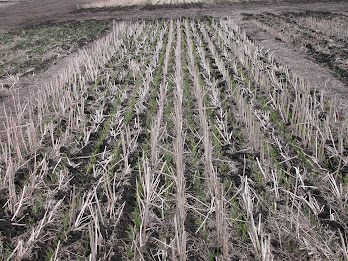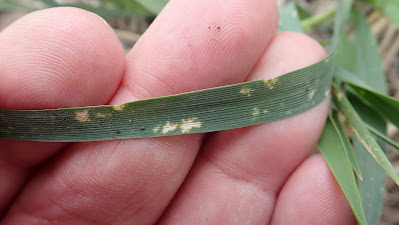Our PCDMN wind trajectory and weather update for June 7-13, 2022 is a bit delayed. However, the overall Prairie rust risk for this period is low given generally limited rust development in source USA locations. Stay tuned for further updates.
1.
Rust development in source USA locations, June 7-13, 2022:
a. Pacific Northwest (PNW)
i. A
report from Dr. X. Chen, USDA ARS, Pullman, WA on May 12, 2022 indicated that limited
stripe rust has been observed in most commercial fields surveyed in Washington State
and Oregon (https://striperust.wsu.edu/2022/05/12/stripe-rust-update-may-12-2022/).
There have been some reports of low levels of stripe rust in nurseries and a
few commercial fields in Washington State and Oregon (Drs. X Chen, C. Hagerty,
and C. Neely, https://www.capitalpress.com/ag_sectors/grains/stripe-rust-begins-to-develop-in-pacific-northwest/article_adad3968-d238-11ec-9a92-ef9380ff3c6f.html;
https://osu-wams-blogs-uploads.s3.amazonaws.com/blogs.dir/2823/files/2022/05/2022_May_Rust.pdf;
https://twitter.com/WSUVarietyTest/status/1529914406770860033).
ii. The
latest report from Dr. Chen as of June 2, 2022 (https://striperust.wsu.edu/2022/06/03/stripe-rust-update-june-2-2022/)
indicates development of stripe rust in experimental fields with levels being
severe on lower canopy leaves (these were artificially inoculated to screen for
resistance). However, limited rust has
been observed in commercial fields that were surveyed. Dr. C. Neely also reports stripe rust from
variety trials in Washington State and recommends scouting for this disease (https://twitter.com/WSUVarietyTest/status/1533947400816955392).
iii. Dr.
Chen indicates that as of June 2, 2022 increased moisture and somewhat cooler
temperatures in May and forecast for early- to mid-June will favour further
stripe rust development. Scouting of
winter wheat is recommended as the crop approaches head emergence and anthesis. If the % of plants infected or the area of
leaf infection approaches 5% it is recommended to spray a fungicide, especially
before anthesis.
iv. On
June 14, 2022, Dr. T. Murray, WSU, referenced Dr. Chen’s June 2, 2022 report
and reports by Dr. C. Neely regarding observations of rust in screening
nurseries, while Dr. Neely also reported spraying of susceptible winter wheat
varieties in commercial fields in the Horse Heaven Hills region as a result of
“rust buil-up” (https://twitter.com/WSUSmallGrains/status/1536766353125695488,
https://smallgrains.wsu.edu/latest-stripe-rust-updates/). Dr. Murray also suggests that stripe rust
will likely continue to develop given rain and cool weather, and that although
susceptible varieties may need fungicide if further rust development occurs,
moderately to highly resistant varieties will probably not need fungicide.
v. As of June 13, 2022, there is
currently a relatively low risk associated with the PNW being a significant source
of stripe rust inoculum for dispersal into the Prairie region of Canada. For the PNW, Dr. Chen indicates that fungicide application is
recommended prior to anthesis for winter wheat if the threshold of 5% (see
above) is observed and at herbicide timing for spring wheat fields planted to
susceptible to moderately susceptible varieties.
b. Texas/Oklahoma
i. In
April and May there were reports of leaf rust occurring in Texas and Oklahoma
(in rust nurseries), while stripe rust was reported in Texas in rust nurseries
and trace to higher (on susceptible varieties) levels were reported in some
areas of Oklahoma ([CEREAL-RUST-SURVEY] Small Grains Disease Conditions in
South and Central Texas as of April 6, 2022, Dr. A. Ibrahim; https://twitter.com/OSUwheatdisease/status/1524193946137546754,
Cereal Rust Bulletin, Report No. 1, April 25, 2022 and No. 2, May 27, 2022; https://www.ars.usda.gov/ARSUserFiles/50620500/CRBs/2022%20CRB%20April%2025.pdf,
https://www.ars.usda.gov/ARSUserFiles/50620500/CRBs/2022%20CRB%20May%2027.pdf).
Levels in the rust nurseries appeared to be increased on susceptible
varieties. Stem rust was not reported in
these regions. Drought conditions have
generally limited rust development in these regions. As of June 12, 2022, 100% of the winter wheat
crops have headed in Texas and Oklahoma (https://quickstats.nass.usda.gov/results/D8BA8D9A-73B5-368D-A053-59F56D6B5A87).
Given drought conditions crop development in this region is likely advanced,
while as of June 12, 2022 16 and 35% of the Oklahoma winter wheat crops and 23
and 60% of the Texas winter wheat are rated as being in poor or very poor
condition, respectively (https://quickstats.nass.usda.gov/results/8EC285B3-F5A4-31A0-9C25-615C9BE31683).
In Texas, 53% of the winter wheat has been harvested, while 32% of the Oklahoma
crops have been harvested (https://quickstats.nass.usda.gov/results/0357A5AE-E5C1-3658-A849-8C6A71098F76). As winter wheat crops mature and are
harvested they no longer represent a potential source of rust inoculum for the
Prairie region.
ii. As of June 13, 2022 there is a low risk
associated with the Texas/Oklahoma region being a significant source of stripe
or leaf rust inoculum for dispersal into the Prairie region of Canada.
c. Kansas/Nebraska
i. Earlier
reports for Kansas in May indicate no to limited observations of leaf and
stripe rust (Dr. K. Andersen Onofre, https://eupdate.agronomy.ksu.edu/article_new/wheat-disease-update-may-4th-2022-493;
https://twitter.com/KSUWheatDisease/status/1524047507994648578;
https://cropwatch.unl.edu/2022/wheat-disease-update-may-19;
Cereal Rust Bulletin, Report No. 1, April 25, 2022 and No. 2, May 27,
2022, https://www.ars.usda.gov/ARSUserFiles/50620500/CRBs/2022%20CRB%20April%2025.pdf,
https://www.ars.usda.gov/ARSUserFiles/50620500/CRBs/2022%20CRB%20May%2027.pdf;
https://twitter.com/progressivwilde/status/1527284446185107456).
The lack of appearance of rust is likely
due to warmer temperatures and drought.
ii. Dr.
M. Guttieri, USDA Manhattan, KS reported on June 7, 2022 that cooler
temperatures and rainfall have promoted some development of stripe rust in KS
nurseries, but plants are moving toward ripening (https://twitter.com/Wheat_MaryG/status/1534274584920440834).
Leaf rust was also reported on a susceptible line in KS on June 5, 2022 (Dr.
Guttieri, https://twitter.com/Wheat_MaryG/status/1533491986665283585).
iii. Stripe
rust in KS has also been reported at two locations as of June 2, 2022 (https://twitter.com/WheatBlitzer/status/1532488400166604801
and https://twitter.com/WheatBlitzer/status/1532462782234386442).
iv. On June 3 and 8, 2022, KSU Wheat Pathology and Dr.
E. De Wolf of KSU indicated that limited stripe rust has been observed, while
low levels of leaf rust are occurring in a number of counties. Overall, Dr. De Wolf indicates KS wheat
disease levels are lower than the 10 year average (https://twitter.com/KSUWheatDisease/status/1532881820399828993,
[CEREAL-RUST-SURVEY] Update on Wheat Rust in Kansas as of June 8, 2022, Dr. E.
De Wolf, KSU).
v. On
May 20 and June 10, 2022 Dr. Stephen Wegulo reported no observations of leaf or
stripe rust in Nebraska (https://cropwatch.unl.edu/2022/wheat-disease-update-may-19;
https://cropwatch.unl.edu/2022/wheat-disease-update-june-10).
vi. As of June 13, 2022, there is a relatively
low risk associated with the Kansas/Nebraska region being a significant source
of stripe or leaf rust inoculum for dispersal into the Prairie region of Canada.
Depending on weather conditions and further rust development, this risk may
increase over the next several weeks.
However, winter wheat is progressing towards maturity, especially in
Kansas with 31% of the crop rated as mature and 81% starting to senesce
(colour) as of June 12, 2022 (https://quickstats.nass.usda.gov/results/856125C6-D2CA-30BE-A6D9-79224DDDAB4F;
https://quickstats.nass.usda.gov/results/CCAA354D-E0B6-3DA7-9F40-0777A9EE792F).
As winter wheat crops mature and are harvested they no longer represent a
potential source of rust inoculum for the Prairie region.
2.
Prairie rust observations:
a. Currently, there are no reports of
early season rust development in Prairie winter wheat, which would suggest
potential overwintering, especially of stripe rust (personal communication: S.
Waterman/S. Rehman, Olds College, Lacombe, R. Aboukhaddour, AAFC Lethbridge;
and H.R. Kutcher, U. of S.). On May 30,
2022, G. Brar with the University of British Columbia has reported natural
stripe rust infections in winter wheat and barley plots at the UBC Campus (https://twitter.com/gurcharn_brar/status/1531327915236814848).
More recently in Alberta, R.
Aboukhaddour reported on June 11, 2022 the first occurrence of stripe rust in a
Lethbridge region screening nursery (https://twitter.com/ReemWheat/status/1535678439163764737).
In addition, on June 12, 2022 Dr. Brar
reported further significant development of stripe rust in UBC nurseries in the
Vancouver region (https://twitter.com/gurcharn_brar/status/1536144846544437248).
3. Prairie Crop Development, Weather Conditions, and
Overwintering of Rust
a. Winter wheat – Winter wheat continues
to grow across the prairie region in late May to early June (https://open.alberta.ca/dataset/a7ad3687-1d97-43e4-90a9-66cef8845a68/resource/afa945bd-3ad6-4621-89db-486ca71b8d54/download/afred-itrb-alberta-crop-report-2022-06-07.pdf;
https://publications.saskatchewan.ca/api/v1/products/118112/formats/135746/download;
https://www.gov.mb.ca/agriculture/crops/seasonal-reports/crop-report-archive/pubs/crop-report-2022-05-31.pdf;
https://www.gov.mb.ca/agriculture/crops/seasonal-reports/crop-report-archive/pubs/crop-report-2022-06-07.pdf).
In Saskatchewan, winter cereal crops are reported to be in the jointing/stem
elongation stage although some crops are progressing into the shot blade stage
of development (https://publications.saskatchewan.ca/api/v1/products/118112/formats/135746/download). Winter wheat in Manitoba is reported to be in
the stem elongation/jointing to the booting stage of development although in
eastern regions some crops have started heading out. In some areas concerns regarding wet
conditions and leaf spots has led to fungicide application around the flag leaf
to head emergence stages (https://www.gov.mb.ca/agriculture/crops/seasonal-reports/crop-report-archive/pubs/crop-report-2022-06-14.pdf).
b. Spring wheat – Generally, spring wheat
is at the seedling to 3-4 leaf and tillering stage of development depending on
province and region (https://publications.saskatchewan.ca/api/v1/products/118112/formats/135746/download;
https://www.gov.mb.ca/agriculture/crops/seasonal-reports/crop-report-archive/pubs/crop-report-2022-06-14.pdf).






























.jpg)







